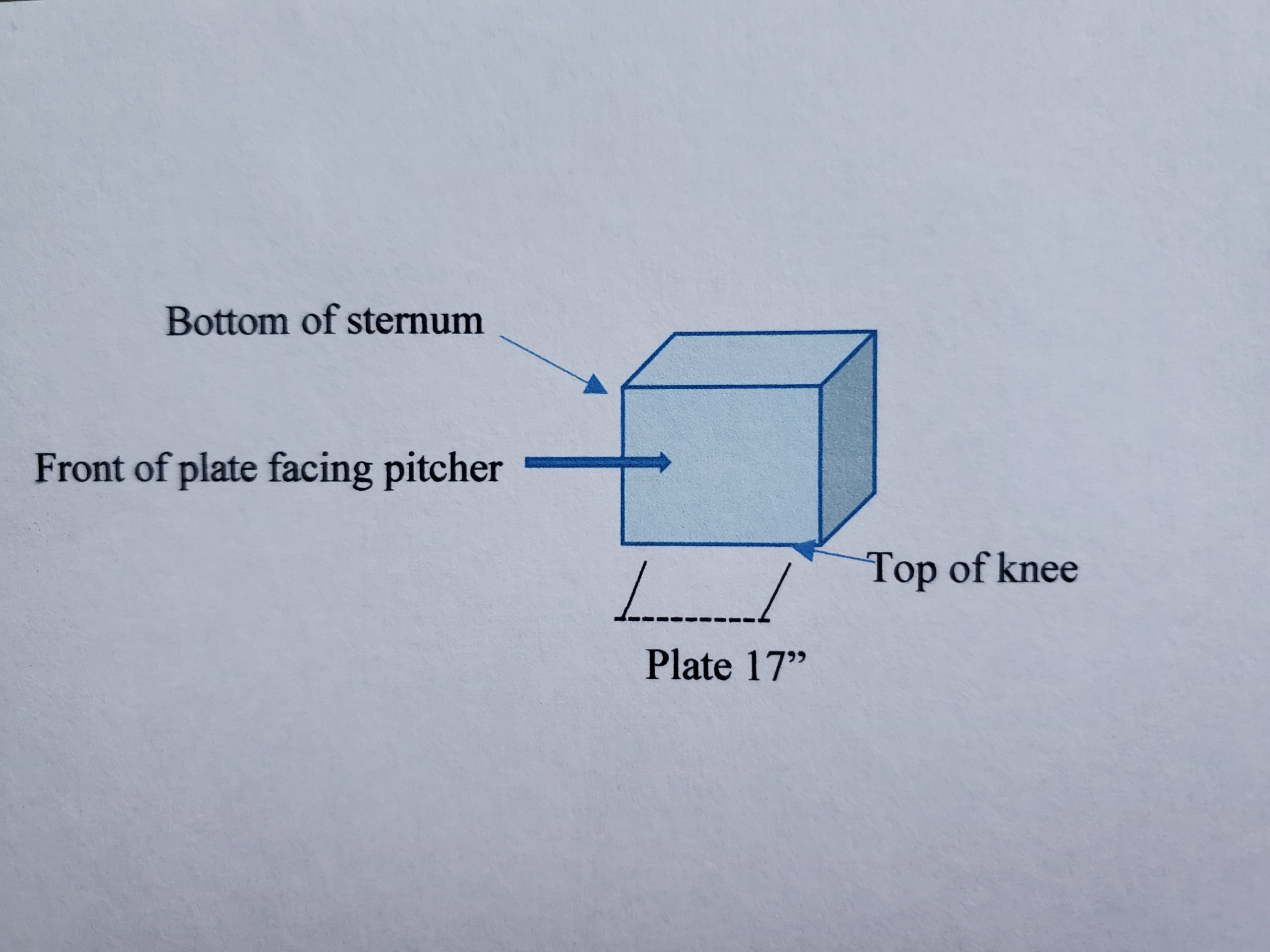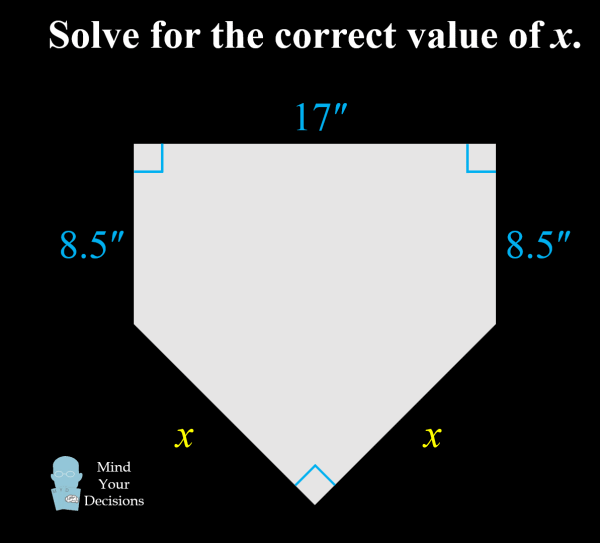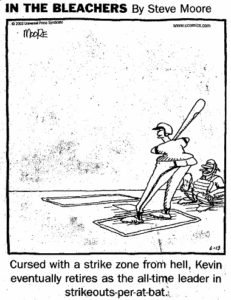Make sure you read the companion article – Mechanics Corner/Plate/Pitches/Strike Zone Mechanics
Still the same and still a Focus Item
The college softball strike zone has not changed for a long time; it is still the zone explicitly described in rule 11.3.1 and in the diagrams on pages 110 and 111 in the NCAA rule book. For the last few years, the strike zone has remained an “In Focus” item in the CCA Manual (Section 1). We are being asked by the SUP to put a special focus on the bottom of the zone. Many pitchers have effective drop balls which are hitting the top of the knee at the front of the plate and then dropping lower, giving the impression that the pitch was low based on where the catcher received the pitch. . Likewise, a good rise ball pitcher will throw a ball that rises just before the plate to catch the top of the knee.
With the focus by the SUP, and the most frequent complaint by coaches being the strike zone, we will delve deeply into all aspects of the strike zone. Let us start with the definition of the NCAA strike zone, which has multiple factors:
• The area above home plate between the bottom of the batter’s sternum and the top of her knees when she assumes her natural batting stance.
• The top of the ball must be on or within the horizontal plane and either side of the ball must be on or within the vertical plane of the strike zone unless the ball touches the ground before reaching home plate. See the diagram below.
• The pitch shall be judged as it crosses the plate in relation to the batter’s natural stance as the pitch crosses the plate.
• The strike should be called if any part of the ball enters the strike zone above any part of home plate within the horizontal and vertical parameters.
That is the rule; now let us discuss the three major aspects of the strike zone for each individual batter:
• The area above home plate
• The horizontal aspect (home plate plus diameter of ball on both sides of the plate)
• The vertical zone (batter’s bottom of sternum to the top of the knee)
Suggestion: have the two diagrams in the Rule book open as you read these next sections.
Major aspects of the zone
Area above home plate
To get a better perspective of an actual strike zone, it is helpful to visualize it as a hexahedron (not a cube, as all six sides are not squares) above the entire plate; some umpires insist that the pitch should be judged as it passes the front of the plate which would make it more like a rectangle. This is not accurate – per rule the strike zone is the area above home plate, which translates as the entire area, not only the front.
Visualize this 3-dimensional zone (also called a cuboid) above the plate with the top at the bottom of the sternum, the bottom at the top of the knees, and each of the sides parallel with each of the inside lines of the batter’s box.

The plate umpire should visualize this 3D zone after setting for the pitch, track the pitch from the pitcher’s release, see where the pitch is when it hits the front of the plate, then track the ball to the catcher’s glove. If it enters the strike zone anywhere above the entire plate, not just its front, it is a strike. You should not be influenced by where the catcher receives the pitch, as you should have already decided the pitch was in the zone or not.
Sometimes heard, but only partially true – umpires should judge the pitch as it crosses the front of the plate. A more accurate statement is – we should start judging the pitch when it crosses the front and continue judging it as it crosses the entire home plate (17” from front to point). Tracking the pitch to the catcher’s glove will allow you to correctly judge the extreme rise balls and drops that college pitchers are capable of throwing. How many of us have made a quick judgment based on the front of the plate, then realize the pitch dropped into the zone, or the rise ball moved up into the zone, as it crossed the last part of the area above the plate?
Horizontal zone
The horizontal aspect of the strike zone includes the 17” of the plate plus the outer edge of the ball. The diameter of the ball is 3.82”. By including this extension for both sides of the plate, the actual (and “callable”) strike zone is 24.64” wide. If the circumference of the ball barely grazes the plate, it is a strike if it also satisfies the vertical zone. This horizontal aspect is fixed and is the same for every batter. That is why this section is much shorter than the following (fixed vs variable).
Vertical zone
The vertical aspect of the strike zone is determined by the space between the batter’s bottom-of-sternum to her top-of-knee, with the obvious added caveat that the pitch must also satisfy the horizontal aspect of the zone. And we must not forget an important part of the rule covering the strike zone – “… in relation to the batter’s natural position as the pitch crosses the plate.”
• The top of the ball must be at or below the bottom of the sternum and,
• The top of the ball must be at the top or above one of the batter’s knees zone (although the rule uses the plural “knees”, if the top of the ball is at the top of either knee, it is a strike).
These two parameters give us the upper and lower limits of the zone; the pitch must be within these limits.
Note the above emphasis on the word “top” as this is different from other codes which allow “any part of the ball” to be in this vertical aspect and be called a strike.
This vertical aspect is variable, dependent upon the distance from the batter’s bottom-of-sternum to her top-of-knee. It changes from batter to batter; it is unusual for two (or more) batters to have the same exact height and natural batting stance. It is more likely that an umpire will have as many as 18 different strike zones during a game (for starting players), and probably more as substitutes are entered.
There may be some confusion regarding the bottom of the vertical zone. As mentioned above, the rule book has the word “knees.” All batters do not have a stance with both knees at the same height. We are now seeing more batters with a stance in which one knee is lower than the other knee. Umpires need to recognize this and be aware that the correct ruling is to use the top of the knee closer to the ground as the bottom parameter for the zone. Think of it this way – the exact point at the top of the lower knee is the point from which the bottom of the zone is extended to make the bottom line of our visual 3D zone.
The strike zone should be called based on the batter’s bottom-of-sternum to top-of-knee area when she is established in the batter’s box in preparation for the imminent pitch. It is not determined when the batter is swinging at the pitch. The rule book uses the word “stance” which is defined as “the position of both body and feet from which an athlete starts.” The zone is not based on a “hitting stance” – a term used by some umpires for when the batter is actually swinging at the pitch.
Home plate as it applies to the strike zone
How often have you heard – “that ball hit the corner” or “hey, blue, that plate has corners”? Yes, it does have corners (definition time – a corner is the place where two converging lines meet). There are actually five corners on the plate; spectators are typically referring to the front corners in the above quotes. So yes, the spectators are correct with regard to the second quote. And it is only these two corners at the front of the plate that might determine a strike. For a pitch to be a strike at its outer limits of the horizontal aspect, it must touch a side of the plate which is parallel to the batter’s box line; yes, the corner does include this parallel side.
Tips for calling strikes
We must work for an accurate strike zone throughout the game. In the past there has been an emphasis on being consistent as well as accurate. We will no longer being talking about consistency because if we are accurate as our top priority, our zone will be consistent. With that in mind, an aggressive strike zone is better than a tight strike zone. This does not mean that you call strikes that are not strikes. What is the difference?
• An aggressive strike zone means the umpire does not miss the strikes at the outer edges of the zone
• A tight zone indicates that the umpire is missing those strikes.
Use your tools
The first step is to realize that, as plate umpires, we have a valuable tool in our kit – our brush! Let your catchers and batters know from the start, by communicating non-verbally with that tool, that you are very aware of the outer edges of the plate and will call them.
• After the defense has finished its warm-up pitches in its half of the first inning, wait until both the batter and catcher are in the area of the plate.
• Make a bit of a production by sweeping off the outside edges on both sides of the plate as well as the plate itself.
• Continue to do this at the beginning of each half-inning, so the batters and catchers have constant reminders that the corners are strikes (within the vertical zone).
Use this only if you feel comfortable with doing so – quietly, and making it appear that you are talking to yourself but just loud enough for the batter and catcher to hear, as you are sweeping the corner, “I like the outside edges of the plate to be really clean”
If there is black around the outside edges of the plate it is not included in that 17″. But we also know that if the pitch grazes the outside edges, a strike call is a good call. And we also know that catchers will frequently tell their teammates what kind of zone “blue” is calling. We do not have to be rocket scientists to realize that the more hitters swing, the fewer pitches we have to call. One big caveat – follow through with this by ringing up strikes on the outside edges or all this effort is wasted.
This is NOT implying that we get wider than the actual zone. Stay with your accurate zone. Use this procedure if, during the game, the catcher makes a few comments about slightly wide pitches being judged as balls and not strikes – call time, take your brush out, walk around the plate, and slowly dust it off. If appropriate, with a few comments which only the catcher (and maybe batter) can hear, make it clear that those pitches are not hitting the corner.
Taking the vertical aspect to another dimension (pun intended)
Here comes the math
As far as the vertical dimensions of the strike zone, here are some statistics for college softball athletes, taken from multiple studies:
• One of the smallest players who played college softball was 4’11”
• The tallest players do not get much bigger than 6’2”.
• The average height of a college softball player is between 5’6” and 5’7”
• The average distance from the bottom of the sternum to the top of the knees for a 5’7” female is about 22”.
Putting all these factors together it could be said that the strike zone for an average college softball player is a cubic area that is 24.64” wide, 17” in depth, and has a vertical length of 22”. This equates to just over 5.3 cubic feet for the strike zone for an average player.
Note 1 – different batters’ heights result in different vertical aspects for each batter
Note 2 – taking the smallest and tallest players, the strike zone could go from 4.75 cubic feet (player height 4’11”), to 5.95 cubic feet (player height 6’2”)
That’s it for the article on the Strike Zone. Now, if you want to read further, be prepared for a completely irrelevant, yet to this author, an interesting fact about home plate.
More than you probably wanted to know (keep reading only if you want to know)
We will start with an audacious fact of which many umpires are not aware – the dimensions of home plate are wrong! The size of the home plate listed in both baseball and softball rule books have dimensions which are mathematically impossible.
Home plate and the strike zone
The original home plate created for baseball was made as a 17-inch square with two corners removed, with the intent to create a point at the back of the plate to designate the extension of the foul lines and the perimeters of fair ball territory. It has not changed, in either baseball or softball, since its original creation by baseball more than 100 years ago – a five-sided shape with the top edge 17 inches; its two adjacent sides 8.5 inches; and the remaining two sides defined to be 12 inches each, meeting at a right angle 17” from the front of the plate.
More math – and how it proves that the dimensions are impossible

1. Connect the two points that are opposite the sloping lines – it will be 17”

2. This line divides home plate into an upper rectangle and a lower isosceles right triangle.
3. The isosceles right triangle has a hypotenuse of 17 inches.
4. If each leg of the triangle has a length x (shown in the above diagram), then by the Pythagorean Theorem the sum of the squares of the legs has to be the square of the hypotenuse.
5. The square of the hypotenuse (172) is 289; its legs must be 12.02 inches (x2=172/2, x=17/√2 ).
So, technically the sloping sides should be slightly longer than 12 inches! Softball copied the dimensions of home plate from baseball. While the error is quite small, baseball and softball are both games of inches. Perhaps the next iteration of the rule book will include the language the sides should be “approximately 12 inches” to be mathematically correct. But, probably not, as this rule for home plate has been in the books for baseball since 1900 and for softball since at least 1937 (the oldest softball rule book this author can find is Official Softball Rules 1937, published by Wilson Sporting Goods Co). So, it stands to reason both softball and baseball will continue with this tradition, even if it is slightly incorrect mathematically.

